Criteria for non-footbridge crossing
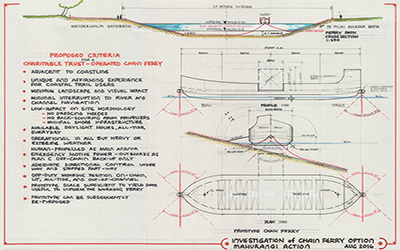
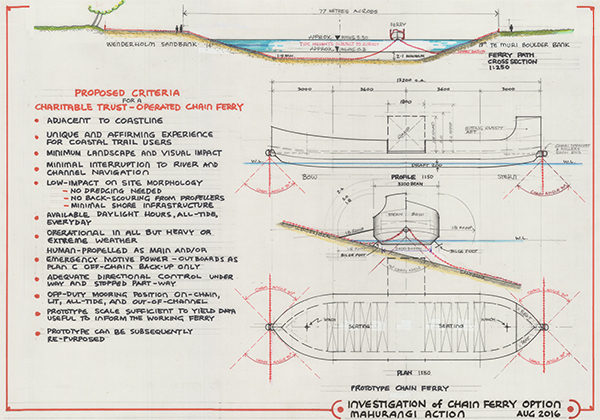
Satisfying Litany of Criteria: All-tide, unobtrusive, sustainable, and achievable. The alternative—diverting the Mahurangi Coastal Trail upstream three kilometres and building a footbridge nearly as long as the one Auckland Council estimated might cost $10–20 million—would involve a far-from-family-friendly four-kilometre return walk to the coast at Te Muri, through difficult terrain. rendering Jefferson Chapple
There were good and obvious reasons for considering a footbridge.
But there were also a good many reasons why a footbridge across the Pūhoi Estuary, as part of the long-proposed Mahurangi Coastal Trail, was a less-than-optimal solution.
Firstly, it would have had to be very long. So long in fact, in one of the alignments considered, it would have close to rivalled the claimed longest footbridge in the Southern Hemisphere—the 395-metre-long Whananaki Footbridge. Length, in a bridge, equals cost, regardless of whether or not Auckland Council’s coastal engineer’s $10–20 million estimate was wildly over-the-top.
Secondly, and most importantly, was the potential landscape and visual impact of such a long structure. By snaking the route in estuarine curves, it was hoped the form might jar less on the sinuous landscape. Accordingly, a landscape architect was commissioned to produce a preliminary rendering of a structure that many people would have found entirely pleasing, in the context facilitating a coastal trail. It would have been a huge stretch, however, to claim that such a footbridge would have enhanced the visual environment of the estuary…
Lastly, as quoted in the Regional Parks Management Plan Te Muri Variation Hearings Report:
Ngāti Manuhiri opposes any further crossing of the Pūhoi River.
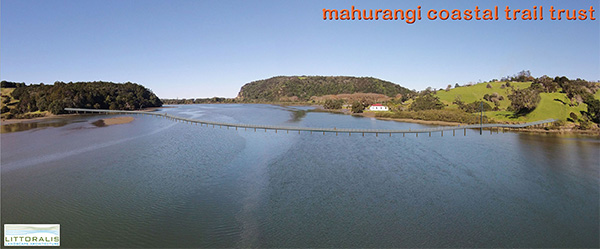
Beauty in Eye of the Beholden: If the proposed Judge Arnold Turner Footbridge had been the only practicable means of crossing the Pūhoi Estuary, beholden users of the Mahurangi Coastal Trail might have found this an entirely elegant structure to behold. But, in addition to Auckland Council’s estimate that it could have cost $10–$20 million, there is not argument that a river-mouth ferry will have a fraction of the landscape and visual impact. rendering Littoralis Landscape Architecture drone image Majorlook Productions
This, apparently, is on cultural grounds. But people of other cultures also saw the proposal to impose such a significant structure in the setting of a regional park as disrespecting its maurilife force, vital essence, special nature. Possibly, if there had been no alternative way of walking the coastline… But there is at least one option worth considering, and the council itself suggested it:
Another possibility is the provision of a chain cable ferry. Such ferries are common throughout Europe. This could be self-operated by people wanting to access Te Muri from Wenderholm and could become a unique attraction in itself without the need for large infrastructure crossing the river. It may however be tide dependent.
This, then, provides a rationale for investigating a chain ferry operation, which not to say that other options should not also be explored. Such options might include a cable car, utilising the elevated terrain to the north of the Pūhoi river mouth, and a footbridge very much further up the Pūhoi River. The latter option would involve a much longer route, further and further away from the coast, and because it would dominate the foreshore boundaries of neighbouring private landholdings, it could be considered an unreasonable imposition on them.
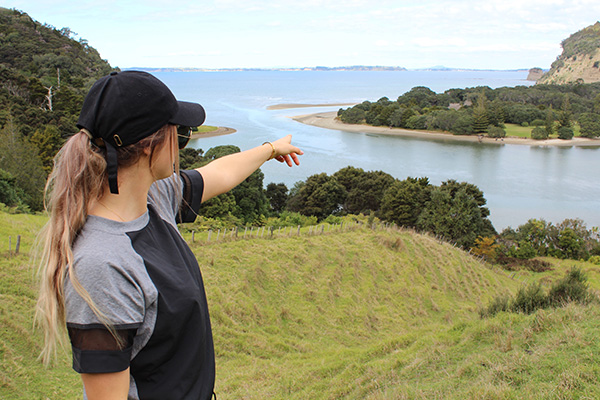
Transferring Affections: Despite Mahurangi Action spending five years promoting the concept of a ‘Judge Arnold Turner Footbridge’ across the Pūhoi Estuary in the vicinity of the Schischka Homestead, the second that Auckland Council offered a better, less visually obtrusive alternative—a chain ferry—the organisation transferred its attention to the Pūhoi river mouth. Here, president Tessa Berger indicates to it—the only point at which a ferry service could operate across the estuary, at all states of the tide, short of walking most of the way to Pūhoi. photographer Caitlin Owston-Doyle
After spending five years exploring footbridge options, Mahurangi Action could have been excused for being completely and utterly confounded, when informed just six weeks out from the hearings on the future of Te Muri, that that option was now, effectively, prohibited. On the contrary:
- Mahurangi Action had always desired a robust examination of all reasonable crossing options
- Auckland Council had warned from the outset that the bar was set extremely high in respect to landscape and visual impact
- Auckland Council had just agreed that Te Muri should remain car-free forever; and, as already mentioned,
- Auckland Council officers, simultaneously with recommending against a footbridge, suggested an attractive alternative.
So, when Mahurangi Action appeared before the commissioners considering submissions on the variation in respect to Te Muri, it was instantly on-board with the chain ferry concept, and presented a visualisation of the operation. Predictably, some submitters were oblivious of the changed landscape, and others, impervious to it, and attempted a doomed defence of the long bridge.
When an assumed solution is suddenly replaced with a radically different one, it is to be expected that it face resistance. But in this case, those who have had the pleasure of crossing a river aboard a cable ferry, or had knowledge of the widespread application beyond Aotearoa, will generally take little convincing. But rather than risk the impression that a chain ferry is being embraced simply because it was the first alternative proffered, the criteria for a river crossing had been exhaustively worked through. This was considered of such fundamental importance that a short form of the criteriafor the seriously engaged, a longform list of criteria follows is listed on the second visualisation, which was not completed in time to be presented at the hearing:
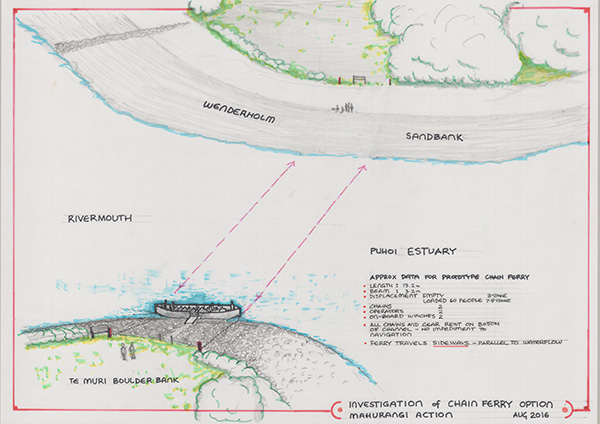
Courageous Council Suggestion: Generally councils are risk-averse in the extreme. And faced with the challenge of protecting the landscape and visual values of the Pūhoi Estuary, Auckland Council could have been excused for kicking for touch on the Mahurangi Coastal Trail. Instead, its officers suggested that a chain ferry might operate, which ‘could become a unique attraction in itself’. rendering Jefferson Chapple
- adjacent to coastline
- unique and affirming experience for coastal trail users
- minimum landscape and visual impact
- minimal interruption to river and channel navigation
- low impact on site geomorphology
- no dredging needed
- no back-scouring from propellers
- minimal shore infrastructure
- available daylight hours, all-tide, everyday
- operational in all but heavy or extreme weather
- human-propelled as main and/or emergency propulsion
- adequate directional control underway and stopped part-way
- off-duty mooring position on-chain, lit, all-tide, and out-of-channel
- scale of prototype sufficient to yield data useful to inform working ferry
As can be more readily appreciated after studying the long-form criteria that appears below, there is physically only one location that a chain ferry could operate, and that is at the Pūhoi river mouth, between the end of the sandspit and the small coastal terrace on the adjacent, Te Muri, shore. The distance across at low tide is a mere 50 metres and the depth just a little more than 2 metres.
The instinct to prefer a ferry crossing further upstream than the river mouth is often expressed. But within 75 metres upstream the channel begins to divide, and the resultant sandbanks prevent low-tide navigation. While some will argue that there is no obligation to provide all-tide access, having coastal trail users stranded on one side or the other, at dusk, would be an operational nightmare, an accidental drowning waiting to happen.
The ‘prototype chain ferry’ visualisation was produced with the specific purpose of aiding an exploration the possibility of producing a prototype that could precede a subsequent vessel, built to survey and fare-charging. However, if funding can be obtained for a naval-architect-designed chain ferry, from the get-go, then any prototyping necessary can be carried out on the built-to-survey craft.
Meantime, by circulating the concept plan widely amongst the cable-ferry fraternity, and beyond, it is hoped to learn details of ferries that operate in closely comparable environments.
Longform criteria for non-footbridge crossing
Criteria for Mahurangi Coastal Trail
This hierarchy of criteria groups begins with for the Mahurangi Coastal Trail itself, which must:
- Be culturally embraced and environmentally sensitive
- Be reasonably adjacent to the coastline
- Be accessibility- and family-friendly
- Be available everyday
- Be traversable continuously during daylight hours (i.e. be all-tide)
- Be adaptable to sea-level rise
- Be economically sustainable.
High-level criteria for crossing
The Pūhoi River crossing must:
- Have a minimal landscape and visual impact
- Be an all-tide crossing
- Not impede navigation
- Be an affirming experience for coastal trail users.
Criteria for ferry crossing
Assuming crossing style is a ferry crossing, without ruling out the possibility, however unlikely, that a preferable alternative is identified, the ferry crossing must:
- Operate in all but heavy or extreme weather
- Not require dredging
Criteria for river-mouth ferry crossing
The previous criteria dictate a river-mouth ferry crossing, as this is the only point at which sand and mud banks don’t impede traverse. A river-mouth ferry crossing must:
- Have only low impact on geomorphology of vulnerable Wenderholm sandspit (northern bank is geomorphically stable, being stone rather than sand)
- Present narrowest aspect to passing vessels (i.e. ferry-glide, rather than proceed at right angles to current)
- Dock without shore-crew assistance
Criteria for cable ferry
The preceding criteria dictate a cable ferry, as jet or propeller driven craft would significantly scour the Wenderholm sandspit. A cable ferry crossing must:
- Minimise cable interference to passing vessels, and vice versa
Criteria for chain ferry
The preceding criterion dictates a chain ferry, as woven wire cables would present a navigation hazard to passing vessels, and risk the ferry itself being disabled. A chain ferry crossing must:
- Possess adequate directional control when underway
- Possess adequate directional control when stopped partway across channel, such as for another vessel passing ahead of the ferry
Criteria for operation of chain ferry
Preceding criteria requires the experience of using the coastal trail be affirming and family-friendly. Operation of a chain ferry must:
- Be human-propelled, or supplemented, if possible, and as emergency propulsion
- When human-propelled, not pose risk to operators, such as through power being reversed to power crank handles.
- Be capable of being operated by one person, in an emergency.
Criteria for chain ferry prototype
The preceding criteria, and the lack information on a chain ferry in a closely comparable operating environment, suggests that prototyping is preferable to proceeding directly to building a chain ferry under survey, and thus at a cost considerably greater than for a ‘disposable’ vessel. A prototype chain ferry crossing must:
- Have alternate, chain-free, means of being propelled and manoeuvred
- Be capable of being operated operated without shore infrastructure
- Draw upon best available knowledge to inform design and operation
- Can be able to be provided at minimal cost and/or have a use beyond the prototyping phase and/or be useful in providing an interim, donation-only, service.

This is a really neat idea.
I’m a local in the Matakana area and formally a landscape architect, although I specialise in geometrics and the design of major highways. I have a wide area of expertise including 3D modelling and would like to offer my services if you need them. I don’t have much time available and am already providing support to a number of other local community projects—bike tracks and playgrounds.
Please feel free to call into our offices in Warkworth for a coffee to see if or how we might be of assistance.
…and this is a red-letter day for the Mahurangi Coastal Trail—looking forward to coffee Monday!